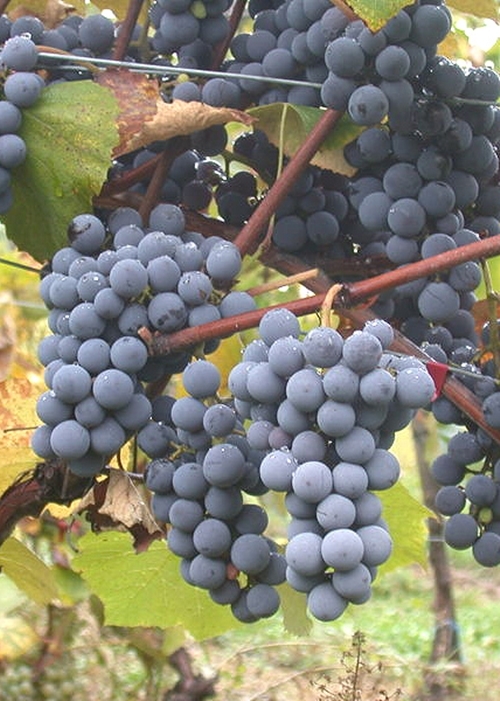
If you’re over a certain age, you may recall the French satirical novel Clochemerle. It was written by Gabriel Chevallier and first published in 1934 though the English translation didn’t appear until some years later. The book is set in a fictional Beaujolais hamlet of the same name and the story revolves around the local squabbles surrounding the installation of a public urinal. In 1972, BBC television produced a popular series based on the novel, much of it filmed on location in France. The British viewers must have thought they were being given a glimpse of The Real Beaujolais but the location sequences were actually filmed in the village of Colombier-le-Vieux over ninety miles to the south in the Ardèche region.
The area known as Beaujolais (boh-zjuh-LAY) lies south of Burgundy and extends about thirty-five miles from the rolling hills south of Mâcon to the flatter lands north of Lyon. The region was first cultivated by the Romans, who sensibly planted vines along their trading route up the Saône River valley to provide sustenance for travelers. Unlike the red wines of Burgundy which rely totally on the Pinot Noir grape, Beaujolais is made solely from Gamay, a purple thin-skinned grape which is low in tannins. Almost all the wines made there are red, full of fruit, easy to drink and food-friendly.
Beaujolais Nouveau is wine which has been fermented for just a few days and released on the third Thursday every November. Technically it’s known as a vin de primeur and it has become famous for the races by distributors to get the first bottles to different consumers around the world. Contrary to popular belief, it’s not a modern fad because the origins of Beaujolais Nouveau date back to the 19th century when the young became all the rage in Paris. These sprightly wines are meant to be enjoyed as young as possible, when they’re at their freshest and fruitiest.
In his splendid book Adventures on the Wine Route, Kermit Lynch writes, “What a concept, downing a newborn wine that has barely left the grape, a wine that retains the cornucopian spirit of the harvest past.” But Beaujolais has changed, much to the chagrin of the Old Guard. Fifty years ago it was simpler stuff, sometimes a bit rough at the edges and rarely exceeded 10-11% alcohol content. Today it is more likely to be 12.5% and crafted for more sophisticated customers who demand fuller flavour, smoothness of texture and – let’s face it – a bit of class.
The quality levels of Beaujolais are easy to understand because there are only three. The lowest is labeled simply Beaujolais and it’s a basic blend using cheap grapes from anywhere in the region. A wine labelled Beaujolais Villages is at the middle level and covers blends from any of thirty-nine small villages in the northern part of the region. Wines from these villages are considered superior to ordinary Beaujolais in that they have more complex aromas and a more satisfying concentration of flavours.
The top-level wines are known as Cru Beaujolais and come from just ten villages in the foothills of the Beaujolais Mountains. The hilly terrain, granite base and sandy clay soil provide an ideal environment for Gamay to express itself to perfection. The name of the individual village usually dominates the label and sometimes the name Beaujolais is omitted altogether. These are the most interesting Beaujolais wines you can buy because each village produces wine with its own special characteristics. In Thailand you might – if you’re lucky – come across Brouilly, Chénas, Fleurie, Morgon and Moulin-à-Vent. These are longer-lasting wines and unlike ordinary Beaujolais, they can keep for several years.
I once found some half-bottles of quite old Moulin-à-Vent in an old and dusty wine shop in South London. They were well over ten years old but still youthful by Moulin standards – some of which can age for decades. The wine was superb: rich dark fruit, earthy woodland aromas and a stunning velvety texture. The next morning I drove back the shop and bought the few bottles that they had left.
You’re unlikely to come across such treasures in these parts but if you buy Beaujolais, look out for the respected names of Bouchard, Drouhin, Duboeuf and Jadot. If you’ve not yet had to opportunity to taste Beaujolais, you might be wondering what it tastes like. Well, Beaujolais is made to be enjoyed young, when it’s full of youthful exuberance. Part from the distinguished Cru Beaujolais, most of the wines are typically youthful, light-bodied and with fresh acidity. Beaujolais tends to have soft, jammy aromas of red fruits such as strawberry, raspberry or redcurrants and the better quality ones come with forest aromas which might even remind you of Pinot Noir. They usually have a gentle mouth-feel and light tannins. These charming wines make a lovely accompaniment for summer or al fresco meals. Ordinary Beaujolais goes perfectly with light meals, omelets, vegetarian dishes and salads and even with light chicken dishes. But do as the French do, and always drink it slightly chilled. Of course in that part of France, it’s the daily swig for in those rustic regions they consume little else.
 |
 |
 |





